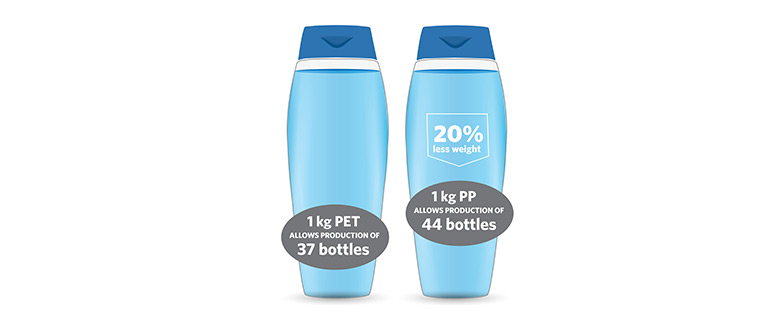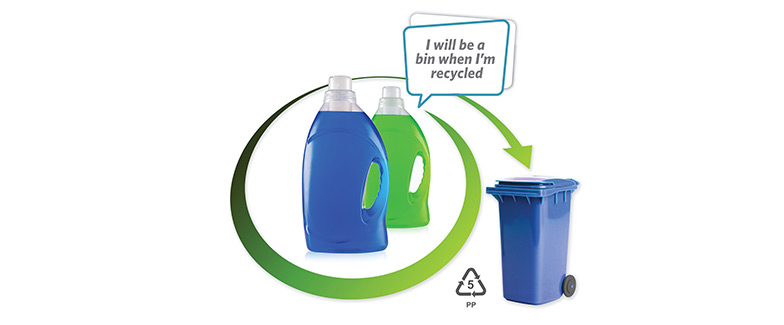Plastic packaging getting smarter and greener
April 15, 2019 by Milliken ChemicalConsumers want smarter, greener packaging, and brands are leveraging polymer chemistry and advanced technologies to respond accordingly. The plastic bottles and containers on your store shelves may look simple, but in many cases they represent very complex designs, material combinations and manufacturing processes. There are various ways to make a package more environmentally friendly, to include: lightweighting, reducing energy use during processing, limiting product waste, enhancing recyclability, and promoting reusability.
At the same time, consumers want a highly functional, aesthetically pleasing package, which often translates into transparency, clarity, attractive colors and high gloss. Advances in technology mean they’re also increasingly benefiting from “smart” in-mold labels on bottles and containers that provide interactivity with the brand.
Polypropylene –– and in particular, NX® UltraClear™ PP, which is made possible only through the use of Milliken’s Millad® NX® 8000 clarifying agent –– is helping to realize these gains.
Let’s look more closely at these various trends:
Lightweighting
Many bottles and containers today rely on multilayer constructions that use a variety of materials to deliver the end result required (such as providing key barrier properties to prevent moisture, UV light and various gases from altering or distorting the contents’ look or performance). Such packaging may yield the necessary performance but can be harmful to the environment. Multimaterial packaging –– with its necessary but dissimilar, often incompatible layers –– can hinder recyclability.
In many applications –– such as for the packaging of many types of cosmetics, home-care and personal-care products –– polypropylene can be used not only in the bottles but also in the caps and labels, offering a viable, mono-material solution that doesn’t require adhesives or glues. Such all-PP containers offer greatly enhanced prospects for being recycled into another useful end product.

Going mono-material
Polypropylene is a strong, durable, lightweight plastic that enables packagers to use less resin while still delivering a highly functional end product. NX UltraClear PP delivers clarity and transparency similar to that of PET, but at much lighter weights. It also yields easy-to-squeeze bottles, and PP’s “slipperiness” enables consumers to squeeze every last drop of the contents out of the package, further reducing waste.
Encouraging recycling
The recycling of plastic packaging is in the spotlight now more than ever, given that the European Union, as part of a planned transition toward a more circular economy, has issued its first-ever Europe-wide strategy on plastics. Under this program, all plastic packaging in the EU market needs to be recyclable by 2030.
As a result, brand owners must find commercially viable options to become more sustainable, and it makes sense in many situations for them to turn to polypropylene as the preferred packaging material. A well-established PP recycling infrastructure exists in many markets, as well as viable end-use applications for those repurposed materials.
NX UltraClear PP is an ideal option, as it offers strength, durability and clarity, all at lighter weights than many competitive materials. And, as noted above, it often provides the ability to produce recycling-friendly, mono-material package solutions.

Making packaging “smart”
While consumers often decide to buy a product in part due to the appearance of its packaging, they also can be influenced by other factors. So-called “smart” labels –– often produced via a process called in-mold labeling (IML) –– can help to inform and engage consumers. During the IML process containers are produced and decorated in a single step. Again, using polypropylene to make both the container and the IML label yields a 100% recyclable package.
By using different combinations of substrates, inks and lacquers –– in-mold labeling has evolved well beyond its popular “orange peel” (or “satin gloss”) finish. It now can yield surfaces with various looks and textures, including several glossy and transparent varieties.
IML labels enhanced with invisible digital watermarks can help to enable greater use of emerging retail technologies at the point of sale, at home and at the moment of disposal.
A consumer, by using an app on a smart phone or tablet, can scan the package to receive instructions how to use the product, identify the origin of ingredients, packaging materials used, and what happens to them after disposal. IML even can offer augmented reality experiences to shoppers while providing valuable user data to the brand owners.
Additionally, these types of labels also can be fused with the bottle during the production process, thereby increasing the level of brand protection to help ensure supply-chain integrity and prevent counterfeiting.
Gaining greater clarity
Consumers like to see what they are buying. Using transparent packaging and colored contents for home, laundry-care and personal-care products can convey a feeling of openness and trust in a brand and is associated with freshness, which is highly valued by many consumers, especially millennials.
Brand owners, meanwhile, also see an opportunity to leverage transparency in their packaging to use color to convey their brand message. And the high gloss offered by PP can enhance the aesthetics and overall look of the package. By using NX UltraClear PP, made with Milliken’s Millad NX 8000 clarifying additive, brand owners now can opt to replace resins such as PET and polystyrene in a wide range of packaging applications, and still realize fully transparent end products with superb, glass-like clarity.
Counting the many benefits
Polypropylene, and particularly NX UltraClear PP, is helping brand owners address the many needs and wishes of today’s demanding consumers. As an added bonus, the material can help converters to boost their yield, while offering better heat resistance than the alternatives (allowing for microwaveability), as well as easy-seal properties. All this added functionality in a single resin also opens the door to greater design freedom when it comes to creating consumer-friendly packaging.
Not that’s what we call smart packaging!
